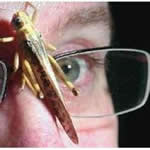Jeff Dawson and a team of researchers at Carleton University are studying how insects fly, right to the smallest detail. The Goal: To use their knowledge to develop micro-air vehicles.
Jennifer Campbell, Citizen Special
 tIt’s late afternoon and Jeff Dawson is inspecting a locust that is glued to a stand with electrodes stuck in its flight muscles. A student uses software to determine what the insect’s muscles are doing during flight.
tIt’s late afternoon and Jeff Dawson is inspecting a locust that is glued to a stand with electrodes stuck in its flight muscles. A student uses software to determine what the insect’s muscles are doing during flight.
In a small room one floor down from this Carleton University biology lab, a locust colony, spread out in half-a-dozen cages, thrives. The creatures eat wheat grass and carrots, fly and mate. They’ll live for about four months under these circumstances and are used for various flight-related experiments in Mr. Dawson’s lab.
Back upstairs, the student is having trouble. This particular creature of biblical renown seems a bit lazy, and the student has to keep blowing air on it to wake it up and get it to fly. As he does, he makes the experiment look pretty low-tech. It all seems like basic biology — except that it has a high-tech purpose.
The lab’s main goal is to understand how insects fly and how their flight systems have evolved.
But there’s a practical purpose to all of this: They want to use the knowledge to develop micro-air vehicles.
“We’re interested in insect flight from a variety of approaches,” Mr. Dawson says. “We do neuro and physiology experiments to record how their brains are speaking to their muscles.”
They then use that information to analyse muscle and wing kinematics to come up with hypotheses they can then test with models. The multidisciplinary lab hires engineering students every summer to help with its studies.
Last summer, an engineering student built a wind tunnel so they could look at locust flight patterns under specific wind conditions. Another engineering co-op student developed a prototype of a mechanism that mimics the flapping motion of an insect wing.
The lab also has a workshop area where Mr. Dawson’s students can build contraptions for their experiments.
They recently built a tank where they can insert an insect flight-simulation device and use coloured dye to analyse the way the wind would hit a real insect’s wing during flight. It works in the water, which remains stationary, because they’ve matched the physics.
With the dye test, they’ve discovered the role and importance of the forewing (locusts have two wings on each side). “The forewing seriously affects the flow over the hind wing and we believe the forewing, when the gap gets too small (on prototypes), destroys the lift produced by the hind wing. That allows extra lift to be produced and cause a steering torque. It’s just like canoeing.”
Several scientists have made breakthroughs over the years about how insects fly. Charlie Ellington discovered the secret of bumblebee movement and others have made similarly important finds.
Mr. Duncan thinks his lab is onto another — namely the importance of the two wings and how they interact.
They’ve extrapolated their discovery to say that when building a micro-air vehicle, two wings on each side is better than one. The extra wing allows the vehicle to carry a greater load.
“So if you wanted to add a camera or a chemical sensor or a drug that you’re delivering to a person trapped in a crumbling building, like a morphine tablet. You can carry more load and you’re more manoeuvrable. So we think this is an ideal insect to be looking at for building these micro-air vehicles — and it all comes back to biblical plague locusts.